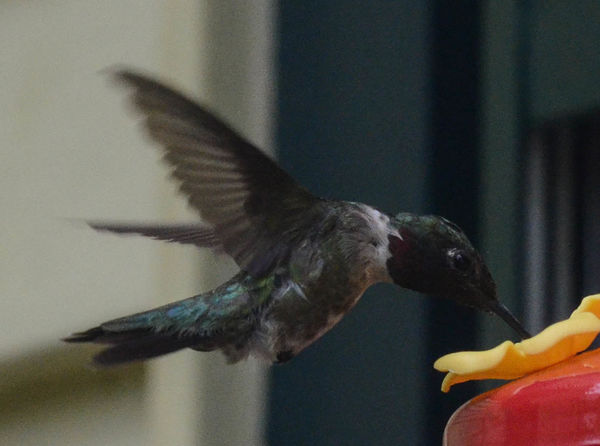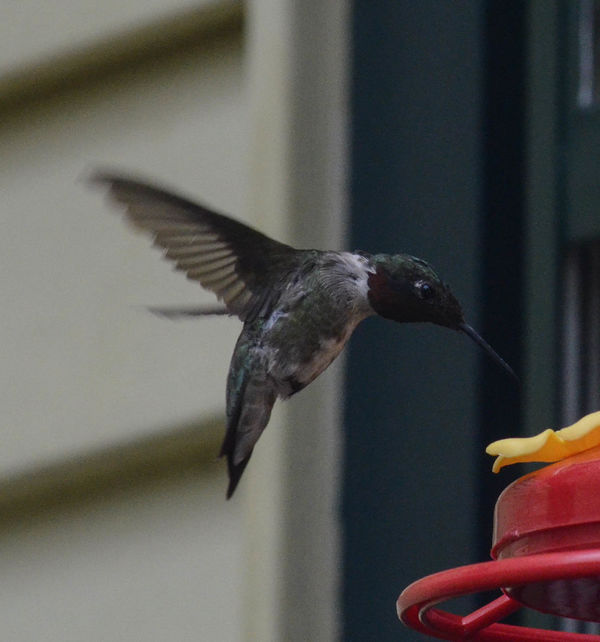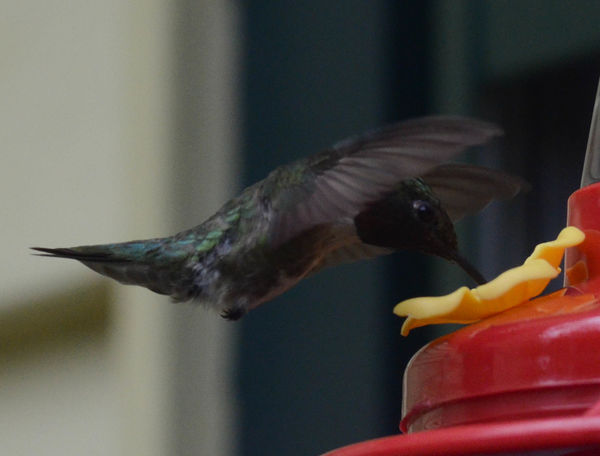My first successful hummingbird pix, but still need more help
Aug 25, 2019 11:39:46 #
Thanks to tips from here, was able to capture these, but know I can do better. Feeder is located in shade, so set my D7000 to 3200 ISO and shutter to 2000 and motor to high continuous. Lens was Nikkor 80-200 F2.8. Pictures have also been cropped. Is there a way to process to eliminate or reduce "graininess" with such a high ISO and enlargement?
(Steps I have already taken include locating another feeder in an area that gets more light.)
Triggering shutter via cable seems to scare off birds after first frame, so took several visits to get these. If I move camera farther away, subject will require even more enlargement. A bit geeked up after these, and an even considering a longer lens, such as a 300.
(Steps I have already taken include locating another feeder in an area that gets more light.)
Triggering shutter via cable seems to scare off birds after first frame, so took several visits to get these. If I move camera farther away, subject will require even more enlargement. A bit geeked up after these, and an even considering a longer lens, such as a 300.
Aug 25, 2019 11:49:07 #
Aug 25, 2019 13:22:57 #
Overthehill1 wrote:
Thanks to tips from here, was able to capture thes... (show quote)
I use fill flash on high speed sync from a lawn chair about 8' from the feeder. If you sit quietly they get used to you, ignore you-don't move fast or jerky-lift the camera smoothly unless you have it on a tripod, pre-aimed and even pre focused on the feeder. When they are disputing ownership of the feeder and doing "chase the birdie" they have used my head for a racing pylon so close they circled me under the brim of my hat and I felt air or a wing tip on my ear. A few times I have forgotten the camera and just watched.
As to lens, I usually use my Canon 100-400 but have also used a Tamron 180 macro with or without a Kenko Pro 300 1.4x on a crop sensor Canon for 403 mm angle of view. For your Nikon a similar rig would be 378 mm angle of view. Being a macro the details are outstanding.
Aug 25, 2019 21:28:17 #
Overthehill1 wrote:
Thanks to tips from here, was able to capture thes... (show quote)
One way to improve your shots, is to use flash!
Aug 26, 2019 07:38:24 #
Overthehill1 wrote:
Thanks to tips from here, was able to capture thes... (show quote)
Well, it's a good effort, but you need to get your settings in order - your ISO is 2000, not 3200, and you had -1 exposure comp dialed in, which may account for the 1 stop (or more) under exposure. Using a shutter speed of 1/2000 is working at the distance you shot these at. If you are further away, you can get to 1/1250 and still retain the wings in the shot with a little blur.
Underexposure, more than high ISO, is the leading cause of image noise. These are dark, and I am sure that if you use an exposure of F4 or F5.6 the images will be much improved. Shoot raw, so you have more options when enhancing sharpness and reducing noise. A longer lens is almost always a good idea, but you shot these at 116mm, when you could have zoomed out to 200mm. You may want to try a teleconverter first - a 1.4X TC will give you 280mm and a max aperture of 4. If you have the old ED version of the 80-200, you can get a Kenko Teleplus Pro 300 1.4X for about $135 new at B and H, or <$90 used on eBay or Fred Miranda's classified listings. I would do all of these things before buying a new lens.
Aug 26, 2019 09:24:08 #
Aug 26, 2019 10:15:24 #
Gene51 wrote:
Well, it's a good effort, but you need to get your... (show quote)
Excellent answer! I have a hummingbird feeder but no hummingbirds yet. I will bookmark this answer to use when they show up!
Aug 26, 2019 10:48:52 #
Overthehill1 wrote:
Thanks to tips from here, was able to capture thes... (show quote)
Don't kick yourself too hard, you're on the correct path towards where you want to go. Look at what you've written. Feeder in shade-very easy solution. The "graininess" is caused by your ISO. Some cameras handle ISO better than others. Your shutter speed won't help you very much. To "freeze" hummers wings a shutter of at least 1/3000 sec is minimal. If you really want to run off your subjects you can try using flash and freezing wings but birds HATE sudden events of any kind, especially light. The use of cable release is effective in very sophisticated wild-life shooting scenarios, you're not there yet. There is nothing in your writing that cannot be resolved with a work-around. The most serious barrier you need to confront is your present lens. 200mm won't get what you want. 300mm will be only a temporary correction. A 300mm lens may satisfy your long-range goals but only when used with an extender. As an example, I am presently using a 400mm lens and each extender for either 560mm or 800mm. My feeders are arranged to allow shooting distances anywhere from 10' to 15' and all can be brightly lit by sunlight. In addition to hummers we are also seeing goldfinch and chickadees. Biggest problem here is shooting in the woods, sun conditions are continuously changing. I can watch glaringly bright sunlight change instantly to evening-like darkness. Shooting hummers can be very boring (while you sit and wait) or very exciting (when hummers show up in force and contest a feeder). Photography was invented to capture hummingbirds, it can be addictive. You are well on your way to finding out how true that can be. Study your photos and critique your results. Figure out what you did to capture what you both like and do not like. Focus upon and benefit from what you like and then run with it. Hummers are seasonal, but your interest can be transferred to other species. Good luck with your shooting, have fun with it.
Aug 26, 2019 10:54:39 #
Not an ideal background, as it camouflages the bird. Maybe choose a different vantage point or hang up a drape of sorts in the background.
Aug 26, 2019 13:09:58 #
rook2c4 wrote:
Not an ideal background, as it camouflages the bird. Maybe choose a different vantage point or hang up a drape of sorts in the background.
Yes, yes, yes. The background is very distracting. If you can, shoot for a location that has a natural green background (trees, bushes) that you can capture out of focus with the proper f stop selection.
Aug 26, 2019 16:09:15 #
Hummingbird images are much more amazing when shot in their natural environment like on flowers, branches, in trees doing their hummingbird thing. And easier to capture a great shot. And they can often be shot at a lower speed. You need light to capture their colorful feathers but not direct sunlight. A diffused light is better.
Aug 26, 2019 16:16:12 #
Put the feeder in a sunnier locale and shoot against the sky or distant background. I had set my camera and 100-400 lens on a tripod with a shutter release cable on burst mode (pre-focused on the feeder itself). It was nice to catch them chasing other hummers away, such acrobats.
Aug 26, 2019 16:29:27 #
Watch out for the distracting light/dark vertical background that also visually cuts the bird.
Aug 26, 2019 18:32:55 #
leenso52 wrote:
Lucky you!!!
There are people who have gotten hummers so used to them they will perch on a finger and sip from a feeder they hand hold. People near me get so many that they post videos that look like swarms of giant bees around whole rows of feeders.
Our local Lowe's had (maybe has-haven't been there in a year) a couple of mated pairs raising broods in the enclosed partly open roof garden department. I was at the register asking the manager about potted dwarf fruit trees when one landed on her shoulder, listened when she spoke to it and then went off into the department. She said it was reminding her it was time to top off the feeders and turn on the misters over the plants. They really loved those misters I once saw one perched under one taking a "shower". She added they would even follow flowering plants that they were feeding at into the parking lot when someone bought them. And when the nursery truck delivered new flowering plants they would fly over to meet the truck and watch the unloading and even feed off the ones on the truck while it was parked there.
Aug 26, 2019 18:45:26 #
I know for many of you hummingbirds are seasonal but here we have them year round. More at certain times, but year round. Some of the local year round ones just migrate up the mountains in summer and back down in winter. I haven't gone to see it but one hummingbird garden on the UCLA campus has at least 200 birds and sometimes more.
If you want to reply, then register here. Registration is free and your account is created instantly, so you can post right away.









